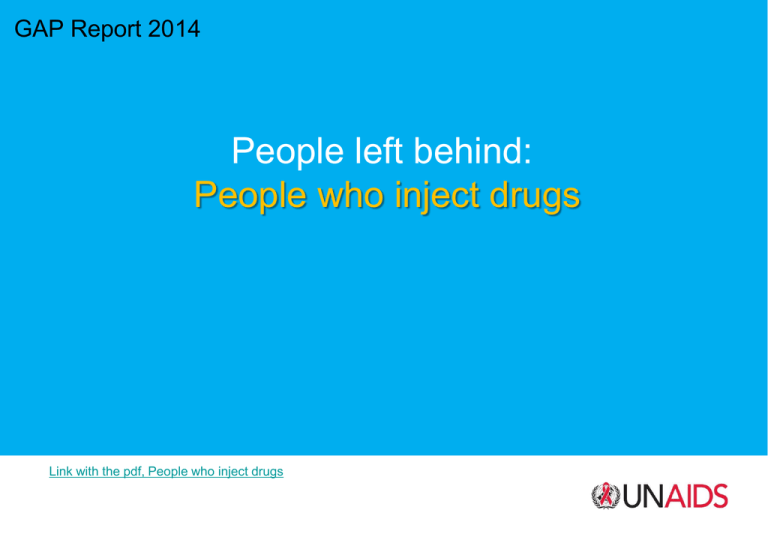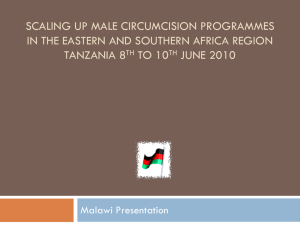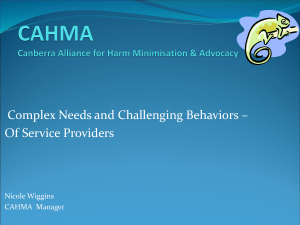
GAP Report 2014
People left behind:
People who inject drugs
Link with the pdf, People who inject drugs
I am an injecting drug user.
I face these issues.
HIV burden
• Injecting drug use is found in nearly every country. It is estimated that
worldwide there are nearly 12.7 million people who inject drugs.
Approximately 1.7 million, or 13%, are also living with HIV.
• HIV prevalence among people who inject drugs is typically far greater than it
is among the rest of the adult population, with people who inject drugs
bearing a 28 times higher prevalence.
• People who inject drugs account for 30% of new HIV infections outside subSaharan Africa.
• HIV prevalence among young people under 25 years old who inject drugs
was 5.2%.
• HIV prevalence appears to be rising in the Asia and the Pacific and in
eastern Europe and central Asia.
HIV prevalence among people who inject drugs
Source: Based on GARPR reporting from 79 countries since 2009, plus the UNODC World Drug Report 2014.
HIV prevalence among people who inject drugs compared
to the general population in countries reporting >30 000 people
who inject drugs, 2009–2013
Source: Global AIDS Response Progress Reporting 2014.
HIV prevalence among people who inject drugs,
by sex since 2011
Source: Based on data submitted through GARPR reporting submitted since 2011. Geneva, UNAIDS.
Why people who inject drugs are being left behind
• Typically, when heroin injection reaches a new community, there is an
exponential increase in HIV transmission.
• People who inject drugs continue to face punitive legal environments, a
variety of human rights abuses and have poor access to services; these and
other factors combine to exacerbate their risks of acquiring HIV.
• Among 30 countries reported data on women who inject drugs, the pooled
HIV prevalence among women was 13% compared to 9% among men from
the same countries.
• Surveys from disparate sites such as Canada, Mauritius and the Republic of
Moldova have found high rates of sex work among injecting respondents and
high rates of injecting drug use among sex-worker respondents.
• Sex workers who inject drugs often have much higher HIV prevalence than
non-injecting sex workers. Transgender women who sell sex and inject drugs
are at an even greater risk of acquiring HIV.
WHY PEOPLE WHO INJECT DRUGS
ARE BEING LEFT BEHIND
THE TOP 4 REASONS
01 Criminalization and punitive laws
02 Absent or inadequate prevention services
03 Widespread societal stigma
04 Lack of investment
Criminalization and punitive laws
• People who inject drugs are almost universally criminalized, either for their
drug-use activity or through the lifestyle adopted in order to maintain their
drug use. Many are in prison or held in detention at some point in their lives,
often for long periods. Estimates suggest that 56–90% of people who inject
drugs will be incarcerated at some stage during their life.
• The majority of national drug control policies focus on supply reduction and
law enforcement against any drug use, and people who use drugs are often
collateral victims of those interventions.
• In various parts of the world, the possession of clean syringes can be used
as evidence to prosecute people who inject drugs or provide grounds for
police harassment, thereby deterring safe injecting practices.
• Compulsory detention centres and prisons often include forced labour and
violence, in contravention of internationally recommended approaches and
human rights. Compulsory detention centres remain common in Asia.
Percentage of countries reporting HIV prevention service
coverage for people who inject drugs by level of coverage
Source: World drug report 2014. Vienna, UNODC, 2014.
Based on data submitted through GARPR reporting submitted since 2011 (only for the number of needles and syringes distributed per
person who injects drugs). Geneva, UNAIDS.
Overview of the level of provision of harm reduction
services
Percentage of people who inject drugs who
were tested for HIV in the last 12 months and
who know the results
Percentage of all people who inject drugs who
were reached by a needle and syringe
programme over the last 12 months
Number of needles and syringes distributed per
person who injects drugs per year
Percentage of opioid dependent people who
inject drugs on opioid substitution therapy
Percentage of all HIV positive people who
inject drugs receiving antiretroviral therapy at a
specified date
a Based
predominantly on behavioural survey data.
Source: World drug report 2014. Vienna, UNODC (1).
Insufficient availability of needles and syringes,
2011-2013
In most countries, HIV service
provision for people who inject
drugs falls below even the lowerlevel targets outlined in the WHO,
UNODC and UNAIDS technical
guide to reduce HIV transmission
among people who inject drugs.
Number of needles and syringes distributed per person who injects drugs
(per year, needle and syringe exchange programmes)
Source: Global AIDS Response Progress Reporting 2014.
Proportion of people who inject drugs living with HIV
who receive antiretroviral therapy
The majority of people who use drugs living with HIV do not have access to HIV
treatment. A World Bank analysis estimates that about one in ten people who
inject drugs and is living with HIV is receiving antiretroviral therapy (compared
to 37% of people living with HIV globally receiving ART)
Source: World Bank literature review and estimates, based on Mathers BM, et al. HIV prevention, treatment, and care services for
people who inject drugs: a systematic review of global, regional, and national coverage. Lancet. 2010;375(9719):1014–1028.
doi:10.1016/S0140-6736(10)60232-2.
Widespread societal stigma
• Many governments find it politically unpalatable to provide adequate HIV
and health services for people who inject drugs, who are a socially
stigmatized and criminalized population.
• People who inject drugs are among the most marginalized and invisible
people in all societies.
• Stigma and discrimination in health- and social-care settings also keep
people who use drugs away. Health services may even exclude people
who inject drugs or treat them badly when they ask for help.
• Evidence indicates that, when women who inject drugs and are living
with HIV become pregnant, they face substantial barriers to accessing
services to prevent their infants from acquiring HIV infection—even more
so than other women who are living with HIV.
Countries reporting >10% of domestic HIV spending on harm
reduction, with the HIV prevalence (%) among people who
inject drugs
HIV prevalence
among people
who inject drugs
Percentage of domestic HIV spending on harm reduction (%)
Source: Based on GARPR reporting since 2010. Geneva, UNAIDS.
CLOSING THE GAP
HOW TO CLOSE THE GAP
01 Transform punitive laws that criminalize the use of drugs
02 Expand evidence-informed services
03 Address institutionalized stigma and discrimination
04 Increase domestic funding for harm reduction programmes
HIV incidence rate among people who inject drugs drops
by 75% in one Chinese city with strong harm reduction
programmes
Source: Ruan Y, et al. Evaluation of harm reduction programmes on seroincidence of HIV, hepatitis B and C, syphilis among
intravenous drug users in southwest China. Sex Transm Dis. 2013;40(4):323–328. doi:10.1097/OLQ.0b013e31827fd4d4.






